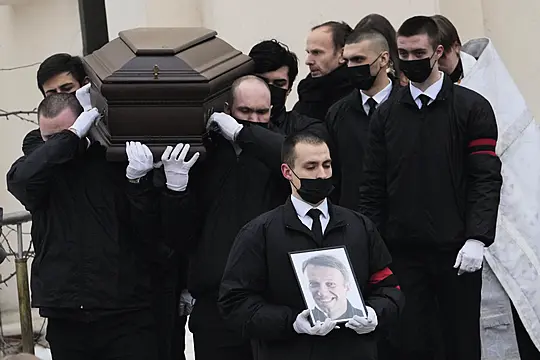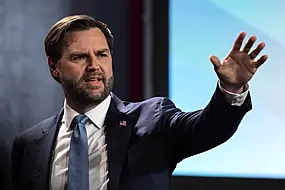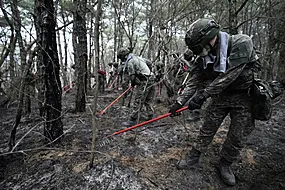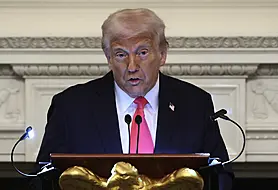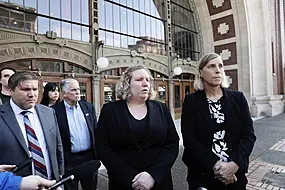Under a heavy police presence, thousands of people bade farewell Friday to opposition leader Alexei Navalny at his funeral in Moscow after his still-unexplained death two weeks ago in an Arctic penal colony.
The crowds who thronged to honour Mr Navalny outside a church and cemetery in a snowy south-eastern suburb of the capital chanted slogans for him and against Russian President Vladimir Putin and the war in Ukraine, turning the event into one of the largest recent displays of dissent. But police did not act against them.
At least 91 people were detained at events across Russia in Mr Navalny’s memory, said OVD-Info, a rights group that tracks political arrests, with most stopped while trying to lay flowers at monuments dedicated to victims of Soviet repression.
When his death was announced on February 16, police detained hundreds who tried to leave flowers.
Mr Navalny was buried after a short Russian Orthodox ceremony, with vast crowds waiting outside the church and then streaming to the fresh grave with flowers.
Mr Navalny’s widow, Yulia, who was not seen at the funeral but has vowed to continue his work, lovingly thanked him for “26 years of absolute happiness”.
In a post on Instagram, she wrote: “I don’t know how to live without you, but I will try to do it in a way that you up there are proud of me and happy for me.”
Mr Navalny’s 23-year-old daughter, Daria, also shared a tribute to her father.
“Ever since I was a child, you taught me to live by certain principles. To live with dignity. You gave your life for me, for mum, for (my brother) Zakhar, for Russia,” she wrote on Instagram.
“I promise you that I will live my life in the way that you taught me, in a way that will make you proud — and most importantly, with a smile on my face.”
The funeral follows a battle with authorities over the release of his body.
His supporters say several churches in Moscow refused to hold the service before Mr Navalny’s team got permission from the Church of the Icon of the Mother of God Soothe My Sorrows, in the capital’s Maryino district, where Mr Navalny once lived before his 2020 poisoning, treatment in Germany and subsequent arrest on his return to Russia.
Many Western leaders blamed the death of Mr Navalny on the Russian leader, an accusation the Kremlin angrily rejected.
On live-streamed footage, his coffin could be seen being taken out of the vehicle, with the crowd applauding and chanting in the background: “Navalny! Navalny!”
Some also shouted: “You weren’t afraid, neither are we!” and later “No to war!”.

Kremlin spokesman Dmitry Peskov urged those gathering in Moscow and other places not to break the law, saying any “unauthorised (mass) gatherings” are violations.
The Church of the Icon of the Mother of God Soothe My Sorrows, which was encircled by crowd-control barriers, did not mention the service on its social media page.
Hours before the funeral was set to start, hundreds waited to enter the church under the watch of riot police who deployed in big numbers.
Western diplomats, including US Ambassador Lynn Tracy, were among those who attended, along with presidential hopefuls Boris Nadezhdin and Yekaterina Duntsova. Both wanted to run against Vladimir Putin in the upcoming presidential elections and opposed his war in Ukraine; neither was allowed on the ballot.

Authorities lined the road from from a nearby subway station to the church with crowd-control barriers.
A photo from inside the church showed an open casket with Mr Navalny’s body covered with red and white flowers, and his mother, Lyudmila Navalnaya, sitting beside it holding a candle.
After the short funeral, a crowd of thousands marched from the church to the nearby Borisovskoye Cemetery, where the police were also out in force for the burial.
With the casket open, Mr Navalny’s parents and others kissed his body. Meanwhile, a large crowd of supporters gathered at the gates of the cemetery, chanting: “Let us in to say goodbye!”
The coffin was lowered into the ground. In keeping with his irreverent sense of humour, music from the The Terminator 2 was played, a movie his allies said he considered “the best in the world”.
Mourners streamed by his open grave, tossing handfuls of soil onto the coffin as a large crowd waited at the cemetery’s entrance. As dusk fell, workers shovelled dirt into the grave while Ms Navalnaya watched.
A mound of flowers, funeral wreaths, candles and a portrait of Navalny sat nearby. Mourners continued to stream into the cemetery until it was closed by police shortly after 10pm local time.
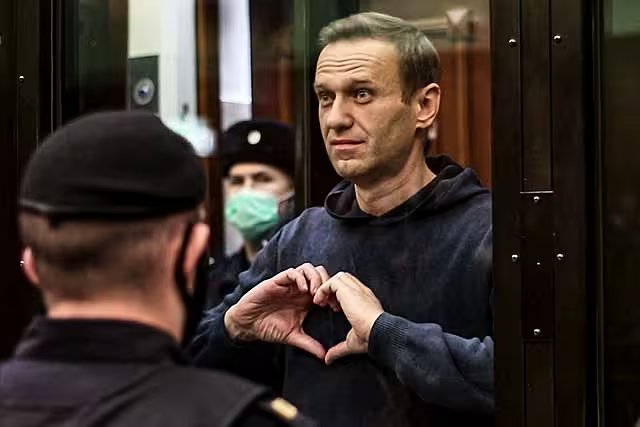
Ms Navalnaya, spent eight days trying to get authorities to release the body following his February 16 death at Penal Colony No 3 in the town of Kharp, in the Yamalo-Nenets region about 1,900 kilometres (1,200 miles) north-east of Moscow.
Authorities originally said they could not turn over the body because they needed to conduct post-mortem tests. Ms Navalnaya, 69, made a video appeal to President Vladimir Putin to release the body so she could bury her son with dignity.

Once it was released, at least one funeral director said he had been “forbidden” to work with Mr Navalny’s supporters, the spokeswoman for Mr Navalny’s team, Kira Yarmysh, said on social media. They also were unable to find a hearse for the funeral.
“Unknown people are calling up people and threatening them not to take Alexei’s body anywhere,” Ms Yarmysh said on Thursday.
Russian authorities still have not announced the cause of death for Mr Navalny, 47, who crusaded against official corruption and organised large protests as Mr Putin’s fiercest political foe. Many Western leaders blamed the death on the Russian leader, which the Kremlin angrily rejected.

Mr Navalny’s Foundation for Fighting Corruption and his regional offices were designated as “extremist organisations” by the Russian government in 2021.
Ms Navalnaya, accused Putin and Moscow Mayor Sergei Sobyanin of trying to block a public funeral.
“We don’t want any special treatment — just to give people the opportunity to say farewell to Alexei in a normal way,” Yulia Navalnaya wrote on X, formerly Twitter.
And in a post on Friday, Ms Navalnaya paid tribute to her husband, saying: “I don’t know how to live without you, but I will try make you up there happy for me and proud of me.”
Лёша, спасибо тебе за 26 лет абсолютного счастья. Да, даже за три последних года счастья. За любовь, за то, что всегда поддерживал, за то, что смешил даже из тюрьмы, за то что ты обо мне всегда думал.
Я не знаю, как жить без тебя, но я постараюсь так, чтобы ты там, наверху,… pic.twitter.com/ybF31AuD47— Yulia Navalnaya (@yulia_navalnaya) March 1, 2024
Moscow authorities refused permission for a separate memorial event for Mr Navalny and late opposition leader Boris Nemtsov on Friday, citing Covid-19 restrictions, politician Yekaterina Duntsova said on Thursday.
Mr Nemtsov, a 55-year-old former deputy prime minister, was shot to death as he walked on a bridge adjacent to the Kremlin on the night of February 27 2015.
Ms Yarmysh also urged Mr Navalny’s supporters around the world to lay flowers in his honour on Friday.
“Everyone who knew Alexei says what a cheerful, courageous and honest person he was,” Ms Yarmysh said on Thursday.

“But the greater truth is that even if you never met Alexei, you knew what he was like, too. You shared his investigations, you went to rallies with him, you read his posts from prison. His example showed many people what to do when even when things were scary and difficult.”
Ivan Zhdanov, director of Mr Navalny’s Anti-Corruption Foundation, said that his funeral had initially been planned for Thursday — the day of Mr Putin’s annual state-of-the-nation address — but no venue agreed to hold it then.
In an interview with the independent Russian news site Meduza, Mr Zhdanov said authorities had pressured Navalny’s relatives to “have a quiet family funeral”.
